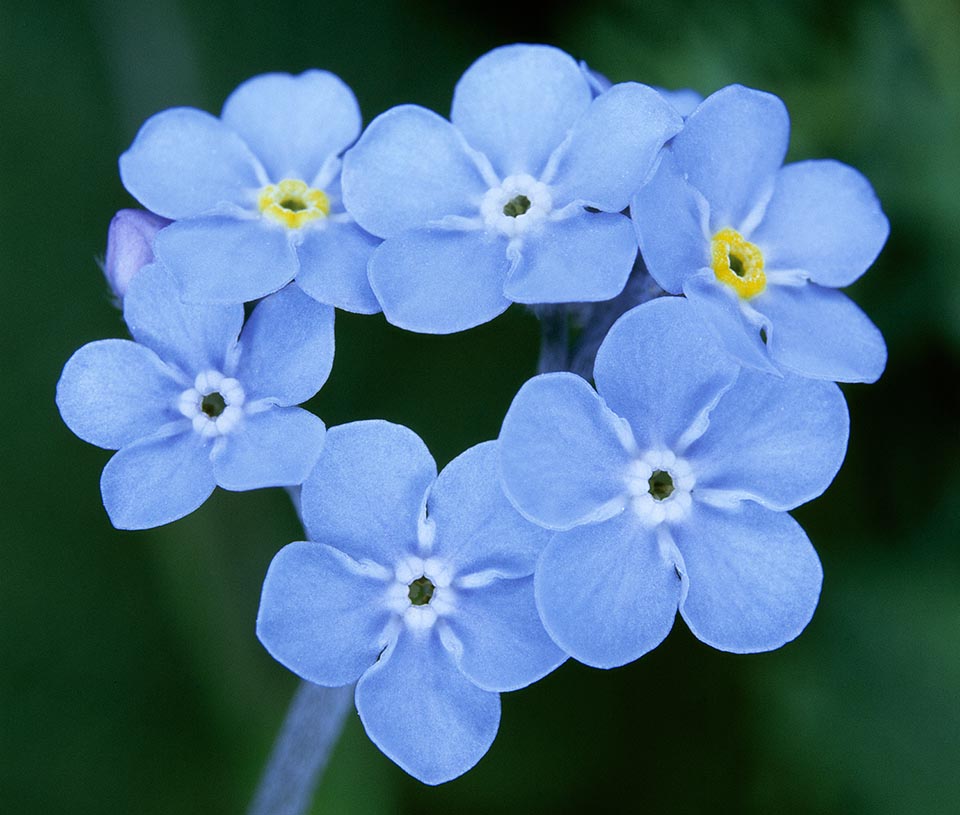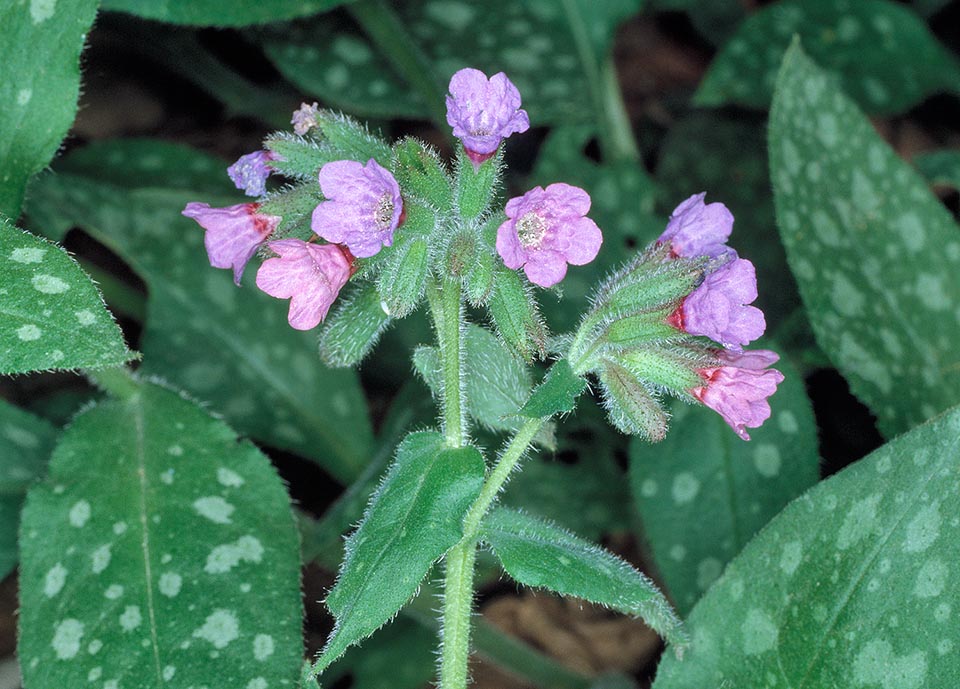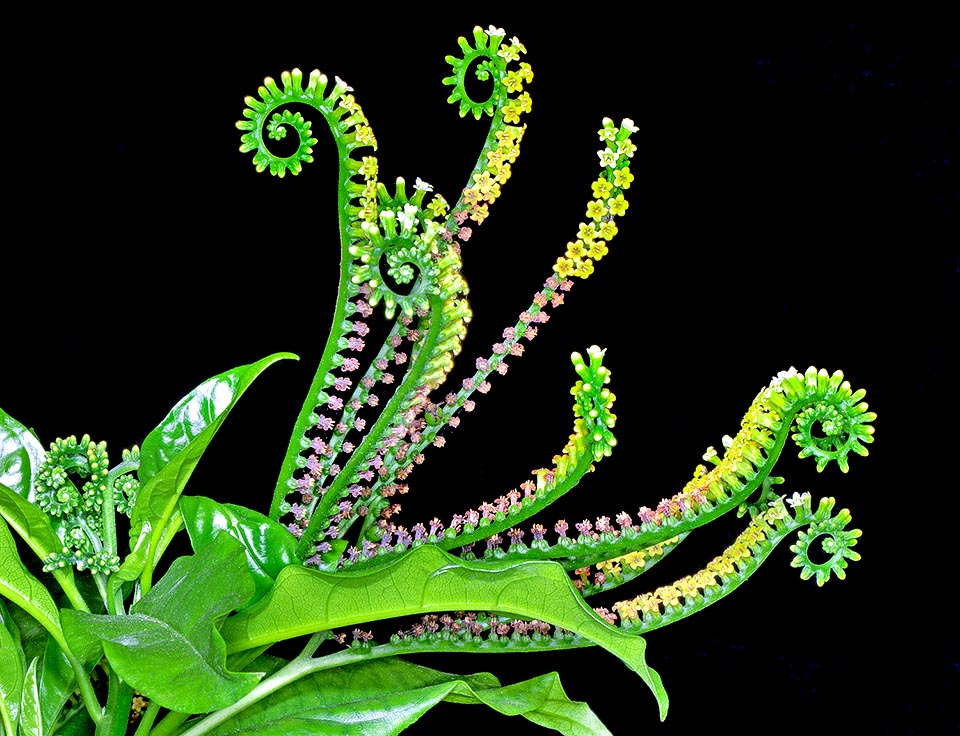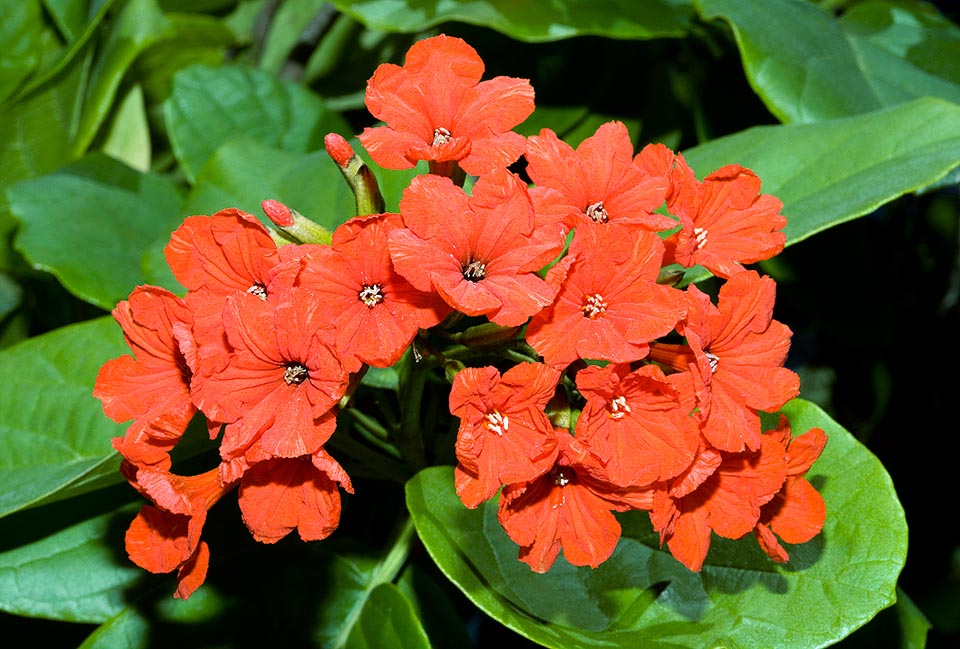
Text © Prof. Pietro Pavone

English translation by Mario Beltramini

Myosotis alpestris who defies Alps cold with its hairiness, is an exception for Boraginaceae, infrequent in temperate-cold and tropical areas © Giuseppe Mazza
The Boraginaceae gather about 2000 species of herbs and shrubs, rarely trees, diffused in the Mediterranean region and in all temperate and subtropical areas, whilst are less frequent in the temperate-cold and tropical regions. They have a vegetative system usually covered by bristly hairs that is sprinkled with large sharp bristles formed by calcareous cells and present on the stems, on the leaves and on the inflorescences. The leaves are usually alternate, that is, arranged in different levels on the stem, usually entire, without stipules, very rough to touch. Exceptions are made by some genera like Cerinthe having glabrous leaves.
The flowers are hermaphrodite, that is, do have stamens as well as pistils, and are actinomorphic or regular, with tendency in some genera to become zygomorphic or irregular (Echium). They are united in inflorescences with simple or double scorpioid cyme.

Several Boraginaceae, as Pulmonaria officinalis, have medicinal virtues, codified in XVI century by Paracelsus in the “Doctrine of Signatures” after which God had put on the plants a sign showing the organ the plant could cure. So these leaves reminding the lung alveoles, hinted toxifuge and expectorant decoctions © Giuseppe Mazza
The calyx is formed by 5 sepals united only at the base, accrescent after the blooming (anthesis). The corolla is formed by 5 merged pistils (gamopetalous). It has a variable shape (a tube shape in Anchusa, a bell shape in Lithospermum, a rotated one in Myosotis) and at times displays scales that restrict the tube entrance to the pollinators (Symphytum, Borago).
The androecium has the same number of elements as the perianth (isostemonous) and is formed by 5 stamens directly inserted on the tube of the corolla. The gynoecium is superior and bicarpellate. Each carpel contains 2 ovules, between which takes form a false septum and so the ovary quite soon becomes quadrilocular and rests on a nectariferous disk shaped like a ring.

Hermaphrodite flowers united in inflorescences with scorpioid cyme, evident in Jamaican Tournefortia staminea recall the mythical many-headed Hydra of Lerna © G. Mazza
The fruit can be tetrachenium, that is, formed, when ripe, by 4 indehiscent parts called mericarps, or a drupe (i.e. Cordia, Tournefortia), rarely a capsule. The seeds usually have little albumen.
Several genera are cultivated as ornamental Heliotropium, Mertensia, Myosotis, Pulmonaria, Echium. Some species have medicinal properties (i.e. Pulmonaria officinalis) and from others, dyes are extracted. Some species are consumed as vegetables, such as, for instance, the Borage (Borago officinalis).
At the spontaneous status, the Boraginaceae are fairly diffused in various types of environment, but especially in the open ones, such as arid and stony meadows (i.e. Cynoglossum cheirifolium) or sandy (i.e. Alkanna tinctoria), and often, even cultivated (i.e. Heliotropium europaeum) and rubbles (i.e. Borago officinalis). Few are the species linked with the wood, like Symphytum bulbosum.

The Boraginaceae family counts many herbaceous or shrubby plants, but also some arboreal species such as this gaudy Caribbean Cordia sebestena © Giuseppe Mazza
Genera
Actinocarya, Adelocaryum, Aegonychon, Afrotysonia Alkanna, Allocarya, Allocaryastrum, Amblynotopsis, Amblynotus, Ammobroma, Amphibologyne, Amsinckia, Anchusa, Anchusopsis, Ancistrocarya, Anoplocaryum, Antiotrema, Antiphytum, Argusia, Arguzia, Arnebia, Asperugo, Austrocynoglossum, Benthamia, Boraginella, Boraginodes, Borago, Borrachinea, Borraginoides, Bothriospermum, Bourreria, Brachybotrys, Brandella, Brunnera, Bucanion, Buglossa, Buglossoides, Caccinia, Calyptracordia, Ceranthe, Cerdana, Cerinthe, Cerinthodes, Cerinthopsis, Chionocharis, Choriantha, Cochranea, Codon, Cohiba, Coldenia, Colsmannia, Conanthus, Cordia, Craniospermum, Crematomia, Crucicaryum, Cryptantha, Cynoglossopsis, Cynoglossospermum, Cynoglossum, Cynoglottis, Cyphorima, Cystostemon, Dasynotus, Decemium, Draperia, Echidiocarya, Echinoglochin, Echinospermum, Echiochilon, Echiochilopsis, Echioides, Echiostachys, Echium, Ehretia, Ellisia, Embadium, Emmenanthe, Eriodictyon, Eritrichium, Eucrypta, Euploca, Eutoca, Exarrhena, Firensia, Gastrocotyle, Gerascanthus, Glandora, Glyptocaryopsis, Gruvelia, Gymnoleima, Gyrocaryum, Hackelia, Halacsya, Halgania, Harpagonella, Havilandia, Heliocarya, Heliophytum, Heliotropium, Hemisphaerocarya, Hesperochiron, Heterocaryum, Hilgeria, Hilsenbergia, Hoplestigma, Howellanthus, Huynhia, Hydrophyllum, Isorium, Ivanjohnstonia, Ixorhea, Krynitzkia, Ktenospermum, Kuschakewiczia, Lappula, Lappulla, Lasiarrhenum, Lasiocaryum, Lennoa, Lepechiniella, Lepidocordia, Leptanthe, Leurocline, Lindelofia, Lithocardium, Lithodora, Lithospermum, Lobostemon, Lutrostylis, Lycopsis, Macielia, Macromeria, Macrotomia, Maharanga, Marcielia, Margarospermum, Massartina, Mattia, Mattiastrum, Megacaryon, Menais, Mertensia, Messerschmidia, Metaeritrichium, Microcaryum, Microparacaryum, Microula, Miltitzia, Mimophytum, Moltkia, Moltkiopsis, Montjolya, Morelosia, Moritzia, Munbya, Myosotidium, Myosotis, Myriopus, Nama, Neatostema, Nemophila, Nephrocarya, Nesocaryum, Nogalia, Nomosa, Nonea, Nonnea, Octosomatium, Ogastemma, Omphalodes, Omphalotrigonotis, Onochilis, Onosma, Onosmodium, Oreocarya, Oreogenia, Oskampia, Osmodium, Paracaryum, Paracynoglossum, Paramoltkia, Pardoglossum, Patagonica, Patagonula, Pectocarya, Pentaglottis, Pentalophus, Phacelia, Pholisma, Pholistoma, Picotia, Pioctonon, Plagiobothrys, Pneumaria, Podonosma, Pontechium, Preslaea, Procopiania, × Procopiphytum, Pseudomertensia, Psilolaemus, Pteleocarpa, Pulmonaria, Raclathris, Rhabdia, Rhytispermum, Rindera, Rochefortia, Rochelia, Romanzoffia, Rotula, Sauria, Schleidenia, Scorpianthes, Sebestena, Selkirkia, Sericostoma, Setulocarya, Sinojohnstonia, Solenanthus, Spilocarpus, Steenhammera, Stenhammaria, Stenosolenium, Stephanocaryum, Stomotechium, Streblanthera, Suchtelenia, Symphytum, Tetaris, Tetraedrocarpus, Thaumatocaryon, Thaumatocaryum, Thyrocarpus, Tianschaniella, Tiquilia, Tournefortia, Trachelanthus, Trachystemon, Traxara, Tricardia, Trichodesma, Trigonocaryum, Trigonotis, Turricula, Tysonia, Ulmarronia, Varronia, Vaupeli, Vaupelia, Viticella, Wellstedia, Wigandia.
→ To appreciate the biodiversity within the BORAGINACEAE family please click here.
